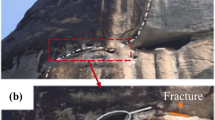Abstract
The phenomenon of roughness induced opening or slip opening is well known in rock mechanics and relates to a crack (or rock joint) behaviour under compression and shear. It has been widely utilised in tight gas and coal bed methane industries to increase the permeability of geological reservoirs during hydraulic stimulations and has recently been extended to geothermal energy technologies for successful harnessing the thermal energy from hot rocks. However, this phenomenon is still poorly understood; and only several semi-empirical equations are currently available in the literature to predict values of the slip openings. In this paper new mechanical and mathematical models of the roughness induced opening are suggested. A computational approach based on the distributed dislocation technique was implemented to analyse various coupled effects. The focus of this paper is on stress analysis of a straight crack with rough faces located in an infinite impermeable body. The crack is subjected to remote normal and shear loading and a uniform fluid pressure applied inside the crack. The developed model can further be extended to investigate many other interesting and practically important problems such as analysis of fracture initiation in natural faults subjected to fluid pressure, residual opening after releasing the fluid pressure or permeability changes associated with hydraulic stimulations.
Similar content being viewed by others
References
Auradou H (2009) Influence of wall roughness on the geometrical, mechanical and transport properties of single fractures. J Phys D Appl Phys 42(21): 214015. doi:10.1088/0022-3727/42/21/214015
Atkinson C, Thiercelin M (1993) The interaction between the wellbore and pressure-induced fractures. Int J Fract 59: 23–40
Barton N, Bandis S, Bakhtar K (1985) Strength, deformation and conductivity coupling of rock joints. Int J Rock Mech 22(3): 121–140
Batchelor GK (1967) An introduction to fluid dynamics. Cambridge University Press, Cambridge
Bilby B, Eshelby J (1968) Dislocations and the theory of fracture. In: Liebowitz H (eds) Fracture, an advanced treatise, vol I, chap 2. Academic Press, New York, pp 99–182
Codrington J, Kotousov A (2007) Application of the distributed dislocation technique for calculating crack closure. Fatigue Fract Eng Mater Struct 30(12): 1182–1193
Codrington J, Kotousov A (2007) A distributed dislocation model for plasticity-induced fatigue crack closure in plates of finite thickness. Int J Fract 144: 285–295
Desroches J, Detournay E, Lenoach B, Papanastasiou P, Pearson JRA, Thiercelin M, Cheng A (1994) The crack tip region in hydraulic fracturing. Proc R Soc Mathe Phys Sci 447(1929): 39–48
Hossain M, Rahman M, Rahman S (2002) Shear dilation stimulation model for production enhancement from naturally fractured reservoirs. Soc Pet Eng J 7(2): 183–195
Koh J, Roshan H, Rahman S (2011) Numerical study of long term thermo-poroelastic effects of cold water injection into naturally fractured reservoirs. J Comput Geotech. doi:10.1016/Jcompgeo.2011.03.007
Kotousov A (2007) Fracture in plates of finite thickness. Int J Solids Struct 44: 8259–8273
Kotousov A, Codrington J (2010) Application of refined plate theory to fracture and fatigue. In: Ho S-Y (eds) Structural failure analysis and prediction methods for aerospace vehicles and structures, chap 5. Bentham Science Publishers, Sharjah, United Arab Emirates, pp 90–103
Matsuki K, Chida Y, Sakaguchi K, Glover PWJ (2006) Size effect on aperture and permeability of a fracture as estimated in large synthetic fractures. Int J Rock Mech Min Sci 43(5): 726–755
Mogilevskaya SG, Rothenburg L, Dusseault MB (2000) Growth of pressure-induced fractures in the vicinity of a wellbore. Int J Fract 104: L25–L30
Nasseri MHB, Mohanty B, Young RP (2006) Fracture toughness measurements and acoustic emission activity in brittle rocks. Pure Appl Geophys 163(5–6): 917–945
Nemoto K, Watanabe N, Hirano N, Tsuchiya N (2009) Direct measurement of contact area and stress dependence of anisotropic flow through rock fracture with heterogeneous aperture distribution. Earth Planet Sci Lett 281(1–2): 81–87
Olsson WA, Brown SR (1993) Hydromechanical response of a fracture undergoing compression and shear. Int J Rock Mech Min Sci Geomech Abstr 30(7): 845–851
Piggott AR, Elsworth D (1991) A hydromechanical representation of rock fractures. In: Proceedings of the 32nd US symposium on rock mechanics, University of Oklahoma, pp 1165–1174
Plouraboué F, Kurowski P, Boffa J-M, Hulin J-P, Roux S (2000) Experimental study of the transport properties of rough self-affine fractures. J Contam Hydrol 46(3–4): 295–318
Plouraboué F, Kurowski P, Hulin J-P, Roux S, Schmittbuhl J (1995) Aperture of rough cracks. Phys Rev E 51(3): 1675–1685
Rahman MK, Hossain MM, Rahman SS (2002) A shear-dilation-based model for evaluation of hydraulically stimulated naturally fractured reservoirs. Int J Numer Anal Methods Geomech 26(5): 469–497
Rose LRF (1987) Influence of debonding on the efficiency of crack patching. Theor Appl Fract Mech 7(2):125–132
Roux S, Plouraboué F, Hulin J-P (1998) Tracer dispersion in rough open cracks. Transp Porous Media 32(1): 97–116
Vilarrasa V, Koyama T, Neretnieks I, Jing L (2011) Shear-induced flow channels in a single rock fracture and their effect on solute transport. Trans Porous Media 87(2): 503–523
Willis-Richards J, Watanabe K, Takahashi H (1996) Progress toward a stochastic rock mechanics model engineered geothermal systems. J Geophys Res 10(G8): 17481–17496
Author information
Authors and Affiliations
Corresponding author
Rights and permissions
About this article
Cite this article
Kotousov, A., Bortolan Neto, L. & Rahman, S.S. Theoretical model for roughness induced opening of cracks subjected to compression and shear loading. Int J Fract 172, 9–18 (2011). https://doi.org/10.1007/s10704-011-9642-6
Received:
Accepted:
Published:
Issue Date:
DOI: https://doi.org/10.1007/s10704-011-9642-6




